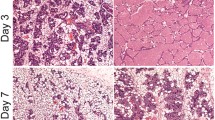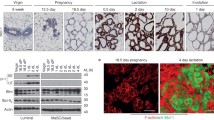Abstract
Maintenance of mammary epithelialdifferentiation and milk production during lactation isa consequence of milk removal and the presence oflactogenic hormones, particularly glucocorticoids,insulin and prolactin. After weaning the fall in lactogenichormones and milk stasis lead to involution, a processthat is mainly characterized by three events: (i)downregulation of milk protein gene expression, (ii) loss of epithelial cells by apoptosis and,(iii) tissue remodeling and preparation of the gland fora new pregnancy. Each of these processes is likely todepend on the activity of specific sets of transcription factors in the mammary epithelium and stromathat ensure the timely and spatially coordinatedexpression of critical gene products such as mediatorsof apoptosis (e.g., caspase-1 and regulators of tissue remodeling events (e.g., matrixmetalloproteinases). Here we describe signaltransduction events such as activation of protein kinaseA and JNK3 and changes in the activity ofseveral transcription factors including Stat5, Stat3, NF1, Oct-1, and AP-1during the early and late phases of mammary glandinvolution. We discuss their possible role in regulatingand coordinating involution with emphasis on theapoptotic process of involution.
Similar content being viewed by others
REFERENCES
A. C. Andres, G. Zuercher, V. Djonov, M. Flueck, and A. Ziemiecki (1995). Protein tyrosine kinase expression during the estrous cycle and carcinogenesis of the mammary gland. Int. J. Cancer 63:288–296.
R. Blaschke, A. C. Andres, H. H. Reid, G. Zurcher, R. R. Friis, and A. Ziemiecki (1991). Tyrosine kinases: From viral oncogenes to developmental regulators. Behring Inst. Mitt. 89:81–92.
T. Burdon, L. Sankaran, R. J. Wall, M. Spencer, and L. Hennighausen (1991). Expression of a whey acidic protein transgene during mammary development. Evidence for different mechanisms of regulation during pregnancy and lactation. J. Biol. Chem. 266:6909–6914.
M. Li, J. Hu, K. Heermeier, L. Hennighausen, and P. A. Furth (1996). Apoptosis and remodeling of mammary gland tissue during involution proceeds through p53–independent pathways. Cell Death Differ. 7:13–20.
L. Hennighausen, G. W. Robinson, K. U. Wagner, and W. Liu (1997). Prolactin signaling in mammary gland development. J. Biol. Chem. 272:7567–7569.
F. Li, R. Strange, R. R. Friis, V. Djonov, H. J. Altermatt, S. Saurer, H. Niemann, and A. C. Andres (1994). Expression of stromelysin-1 and TIMP-1 in the involuting mammary gland and in early invasive tumors of the mouse. Int. J. Cancer 59:560–568.
L. Ossowski, D. Biegel, and E. Reich (1979). Mammary plasminogen activator: Correlation with involution, hormonal modulation and comparison between normal and neoplastic tissue. Cell 16:929–940.
R. Strange, F. Li, S. Saurer, A. Burkhardt, and R. R. Friis (1992). Apoptotic cell death and tissue remodeling during mouse mammary gland involution. Development 115:49–58.
X. Liu, G. W. Robinson, K. U. Wagner, L. Garrett, A. Wynshaw-Boris, and L. Hennighausen (1997). Stat5a is mandatory for adult mammary gland development and lactogenesis. Genes Dev. 11:179–186.
L. Hennighausen, G. W. Robinson, K. U. Wagner, and X. Liu (1997). Developing a mammary gland is a Stat affair. J. Mam. Gland Biol. Neoplasia 2:365–372.
L. R. Lund, J. Romer, N. Thomasset, H. Solberg, C. Pyke, M. J. Bissell, K. Dano, and Z. Werb (1996). Two distinct phases of apoptosis in mammary gland involution: Proteinase-independent and-dependent pathways. Development 122:181–193.
N. I. Walker, R. E. Bennett, and J. F. Kerr (1989). Cell death by apoptosis during involution of the lactating breast in mice and rats. Am. J. Anat. 185:19–32.
M. Schmitt-Ney, B. Happ, R. K. Ball, and B. Groner (1992). Developmental and environmental regulation of a mammary gland-specific nuclear factor essential for transcription of the gene encoding beta-casein. Proc. Natl. Acad. Sci. U.S.A. 89:3130–3134.
R. Jaggi, A. Marti, K. Guo, Z. Feng, and R. R. Friis (1996). Regulation of a physiological apoptosis: Mouse mammary involution. J. Dairy Sci. 79:1074–1084.
A. Marti, B. Jehn, E. Costello, N. Keon, G. Ke, F. Martin, and R. Jaggi (1994). Protein kinase A and AP-1 (c-Fos/JunD) are induced during apoptosis of mouse mammary epithelial cells. Oncogene 9:1213–1223.
A. Marti, Z. Feng, B. Jehn, V. Djonov, G. Chicaiza, H.-J. Altermatt, and R. Jaggi (1995). Expression and activity of cell cycle regulators during proliferation and programmed cell death in the mammary gland. Cell Death. Differ. 2:277–283.
K. Heermeier, M. Benedict, M. Li, P. Furth, G. Nunez, and L. Hennighausen (1996). Bax and Bcl-xs are induced at the onset of apoptosis in involuting mammary epithelial cells. Mech. Dev. 56:197–207.
M. Li, X. Liu, G. Robinson, U. Bar-Peled, K. U. Wagner, W. S. Young, L. Hennighausen, and P. A. Furth (1997). Mammary-derived signals activate programmed cell death during the first stage of mammary gland involution. Proc. Natl. Acad. Sci. U. S. A. 94:3425–3430.
N. Boudreau, C. J. Sympson, Z. Werb, and M. J. Bissell (1995). Suppression of ICE and apoptosis in mammary epithelial cells by extracellular matrix. Science 267:891–893.
R. S. Talhouk, M. J. Bissell, and Z. Werb (1992). Coordinated expression of extracellular matrix-degrading proteinases and their inhibitors regulates mammary epithelial function during involution. J. Cell Biol. 118:1271–1282.
M. T. Travers, M. C. Barber, E. Tonner, L. Quarrie, C. J. Wilde, and D. J. Flint (1996). The role of prolactin and growth hormone in the regulation of casein gene expression and mammary cell survival: Relationships to milk synthesis and secretion. Endocrinology. 137:1530–1539.
M. Peaker, C. J. Wilde, and C. H. Knight (1998). Local control of the mammary gland. Biochem. Soc. Symp. 63:71–79.
A. Marti, Z. Feng, H. J. Altermatt, and R. Jaggi (1997). Milk accumulation triggers apoptosis of mammary epithelial cells. Eur. J. Cell Biol. 73:158–165.
Z. Feng, A. Marti, B. Jehn, H. J. Altermatt, G. Chicaiza, and R. Jaggi (1995). Glucocorticoid and progesterone inhibit involution and programmed cell death in the mouse mammary gland. J. Cell Biol. 131:1095–1103.
L. A. Pena, Z. Fuks, and R. Kolesnick (1997). Stress-induced apoptosis and the sphingomyelin pathway. Biochem. Pharmacol. 53:615–621.
M. Verheij, R. Bose, X. H. Lin, B. Yao, W. D. Jarvis, S. Grant, M. J. Birrer, E. Szabo, L. I. Zon, J. M. Kyriakis, A. Haimovitzfriedman, Z. Fuks, and R. N. Kolesnick (1996). Requirement for ceramide-initiated Sapk/Jnk signalling in stress-induced apoptosis. Nature 380:75–79.
Z. Xia, M. Dickens, J. Raingeaud, R. J. Davis, and M. E. Greenberg (1995). Opposing effects of ERK and JNK-p38 MAP kinases on apoptosis. Science 270:1326–1331.
B. W. Zanke, K. Boudreau, E. Rubie, E. Winnett, L. A. Tibbles, L. Zon, J. Kyriakis, F. F. Liu, and J. R. Woodgett (1996). The stress-activated protein kinase pathway mediates cell death following injury induced by Cis-platinum, UV irradiation or heat. Curr. Biol. 6:606–613.
M. Hibi, A. Lin, T. Smeal, A. Minden, and M. Karin (1993). Identification of an oncoprotein-and UV-responsive protein kinase that binds and potentiates the c-Jun activation domain. Genes Dev. 7:2135–2148.
J. N. Ihle and I. M. Kerr (1995). Jaks and Stats in signaling by the cytokine receptor superfamily. Trends Genet. 11:69–74.
S. Li, and J. M. Rosen (1995). Nuclear factor I and mammary gland factor (STAT5) play a critical role in regulating rat whey acidic protein gene expression in transgenic mice. Mol. Cell. Biol. 15:2063–2070.
X. Liu, G. W. Robinson, F. Gouilleux, B. Groner, and L. Hennighausen (1995). Cloning and expression of Stat5 and an additional homologue (Stat5b) involved in prolactin signal transduction in mouse mammary tissue. Proc. Natl. Acad. Sci. U.S.A. 92:8831–8835.
A. Kumar, M. Commane, T. W. Flickinger, C. M. Horvath, and G. R. Stark (1997). Defective TNF-alpha-induced apoptosis in STAT1–null cells due to low constitutive levels of caspases. Science 278:1630–1632.
D. Apt, T. Chong, Y. Liu, and H. U. Bernard (1993). Nuclear factor I and epithelial cell-specific transcription of human papillomavirus type 16. J. Virol. 67:4455–4463.
T. K. Archer, P. Lefebvre, R. G. Wolford, and G. L. Hager (1992). Transcription factor loading on the MMTV promoter: A bimodal mechanism for promoter activation. Science 255: 1573–1576.
R. A. Graves, P. Tontonoz, S. R. Ross, and B. M. Spiegelman (1991). Identification of a potent adipocyte-specific enhancer: Involvement of an NF-1–like factor. Genes Dev. 5:428–437.
D. A. Jackson, K. E. Rowader, K. Stevens, C. Jiang, P. Milos, and K. S. Zaret (1993). Modulation of liver-specific transcription by interactions between hepatocyte nuclear factor 3 and nuclear factor 1 binding DNA in close apposition. Mol. Cell. Biol. 13:2401–2410.
E. E. M. Furlong, N. K. Keon, F. D. Thornton, T. Rein, and F. Martin (1996). Expression of a 74–kDa nuclear factor 1 (NF1) protein is induced in mouse mammary gland involution. Involution-enhanced occupation of a twin NF1 binding element in the testosterone-repressed prostate message-2/clusterin promoter. J. Biol. Chem. 271:29688–29697.
N. Segil, S. B. Roberts, and N. Heintz (1991). Mitotic phosphorylation of the Oct-1 homeodomain and regulation of Oct-1 DNA binding activity. Science 254:1814–1816.
S. Murphy, J. B. Yoon, T. Gerster, and R. G. Roeder (1992). Oct-1 and Oct-2 potentiate functional interactions of a transcription factor with the proximal sequence element of small nuclear RNA genes. Mol. Cell. Biol. 12:3247–3261.
C. Fletcher, N. Heintz, and R. G. Roeder (1987). Purification and characterization of OTF-1, a transcription factor regulating cell cycle expression of a human histone H2b gene. Cell 51:773–781.
P. Carbon, S. Murgo, J. P. Ebel, A. Krol, G. Tebb, and L. W. Mattaj (1987). A common octamer motif binding protein is involved in the transcription of U6 snRNA by RNA polymerase III and U2 snRNA by RNA polymerase II. Cell 51:71–79.
F. Hafezi, A. Marti, A. Wenzel, C. Grimm, C. E. Remé, and G. Niemeyer (1999). Opposite DNA binding activities of the transcription factors AP-1 and Oct-1 during light induced apoptosis of retinal photoreceptors. Vision Res. (in press).
M. Karin, Z. Liu, and E. Zandi (1997). AP-1 function and regulation. Curr. Opin. Cell Biol. 9:240–246.
S. J. Busch and P. Sassone-Corsi (1990). Dimers, leucine zippers and DNA-binding domains. Trends Genet. 6:36–40.
T. Curran and B. R. Franza, Jr. (1988). Fos and Jun: The AP-1 connection. Cell 55:395–397.
B. Lewin (1991). Oncogenic conversion by regulatory changes in transcription factors. Cell 64:303–312.
P. Sassone-Corsi, J. Visvader, L. Ferland, P. L. Mellon, and I. M. Verma (1988). Induction of proto-oncogene fos transcription through the adenylate cyclase pathway: Characterization of a cAMP-responsive element. Genes Dev. 2:1529–1538.
R. P. de Groot, J. Auwerx, M. Karperien, B. Staels, and W. Kruijer (1991). Activation of junB by PKC and PKA signal transduction through a novel cis-acting element. Nucleic Acids Res. 19:775–781.
F. Hafezi, J. P. Steinbach, A. Marti, K. Munz, Z. Q. Wang, E. F. Wagner, A. Aguzzi, and C. E. Reme (1997). The absence of c-fos prevents light-induced apoptotic cell death of photoreceptors in retinal degeneration in vivo. Nat. Med. 3:346–349.
Z. Feng, H. J. Joos, C. Vallan, R. Mühlbauer, H. J. Altermatt, and R. Jaggi (1998). Apoptosis during castration-induced regression of the prostate is Fos dependent. Oncogene 17: 2593–2600.
E. Hu, E. Mueller, S. Oliviero, V. E. Papaioannou, R. Johnson, and B. M. Spiegelman (1994). Targeted disruption of the c-fos gene demonstrates c-fos-dependent and-independent pathways for gene expression stimulated by growth factors or oncogenes. EMBO J. 13:3094–3103.
M. Karin (1998). New twists in gene regulation by glucocorticoid receptor: Is DNA binding dispensable? Cell 93:487–490.
Rights and permissions
About this article
Cite this article
Marti, A., Lazar, H., Ritter, P. et al. Transcription Factor Activities and Gene Expression During Mouse Mammary Gland Involution. J Mammary Gland Biol Neoplasia 4, 145–152 (1999). https://doi.org/10.1023/A:1018721107061
Issue Date:
DOI: https://doi.org/10.1023/A:1018721107061




